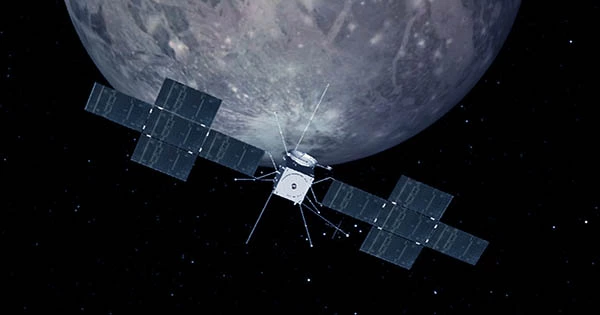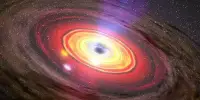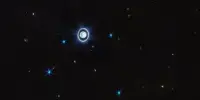Next week, the Jupiter Icy Moons Explorer (JUICE) spacecraft from Europe will begin an extensive exploration of Jupiter’s moons. However, the expedition will only get a fleeting look at Europa, a moon that may contain life. This is why.
Europa’s Jupiter Icy Moons Explorer (JUICE) is a technical marvel, but it wouldn’t last long at Europa since it runs on just half the power of a hairdryer and has a “nuclear bunker” to protect its electronics from radiation. The smallest of Jupiter’s four major moons may be the most likely location in the solar system to harbor alien life in its ice-covered ocean, but NASA claims that the climate surrounding the moon is so severe that a spacecraft would perish there in a few months at most.
It is never simple to go to Jupiter. The closer you go to the gas giant and the longer you desire to stay near it, the more difficult it becomes. Jupiter, which is five times further away from the sun than Earth, dwells in the solar system’s twilight zone, getting just approximately 4% of the sunlight that Earth receives. That implies that any visiting spacecraft that wishes to use solar power must have massive solar arrays. The difficulties just begin here. Jupiter’s magnetic field is 10,000 times stronger than Earth’s, which can affect the spacecraft’s scientific data, according to Justin Byrne, head of Science Programs at Airbus Defence and Space, which headed the team that built the JUICE mission. Worse still, Jupiter and its volcanically active nearest moon Io push particles into space surrounding the planet, trapping and supercharging them in the process. As a result, radiation levels around the planet are as high as those in a nuclear explosion’s epicenter.
Satellite radiation sickness: Europa is Jupiter’s second closest moon, orbiting the planet at a distance of 417,000 miles (671,000 km), about twice the distance between the moon and Earth. The radiation dosage an object in orbit around Europa would get in a day is, at 5.4 Sievert, more than two times the amount that causes serious radiation illness in humans. Radiation levels surrounding Europa are not nearly as high as around the nearest planet, Io, but scientists know that. Of course, a spaceship isn’t a human, but Byrne acknowledges that such radiation levels are higher than what engineers typically plan for. “We are used to radiation in space,” added Byrne. “Missions orbiting Earth must pass through Earth’s radiation belts, but the radiation levels there are nowhere near those experienced by a spacecraft near Jupiter.”
High radiation levels are dangerous for electronics and solar panels. According to Byrne, the more intense the radiation, the sooner electronic equipment fails and solar arrays decay. As a result, NASA’s Europa Clipper mission will not hunt for signs of life on Europa directly from the moon’s orbit but rather will make brief periodic visits while in a broader orbit around Jupiter. As a result, the European Space Agency (ESA) picked Jupiter’s biggest and cozier moon Ganymede as the primary target for JUICE.
Warm Ganymede: Scientists believe that Ganymede is less likely than Europa to have life, yet the moon is still far but dull. Ganymede is the largest moon in the solar system and the only one known to produce its own magnetic field. It is bigger than the smallest planet in the solar system, Mercury. The first moon other than Earth’s own moon to have a spacecraft in its orbit will be Ganymede in 2034, three years after JUICE arrives at Jupiter (if all goes according to plan).
Ganymede, the third closest moon to Jupiter, orbits the gas giant at a distance of 665,000 miles (1,070,000 km). According to Byrne, the radiation near Ganymede is around 100 times lower than that around Europa. Nonetheless, the JUICE spacecraft would not survive in this environment for long without some novel ideas.
A lead-lined vault holds all of the spacecraft electronics (save for the scientific equipment meant to examine the severe environment in the Jupiter system) at the core of the 2.7-ton (2.42 metric tonnes) spacecraft.
On JUICE, there are kilos of lead, according to Byrne. “And that essentially increases the lifespan of the electronics and reduces the quantity of radiation that may reach them. But they will pass away eventually. You can’t halt it permanently.
This lead-lined nuclear mini-bunker would need to be far more durable if the spaceship were to go to Europa, Byrne continued.
Ineffectiveness of solar panels: The solar arrays are totally exposed to radiation, despite the fact that there is a way to shield the electrical components. According to Byrne, the mission’s eventual end will be caused by the solar panels aboard JUICE deteriorating in the hostile atmosphere of Jupiter.
JUICE’s solar panels must be largely due to Jupiter’s distance from the sun and the weak sunlight that surrounds the planet. The arrays, which are made up of two cross-shaped wings, have a surface area of 915 square feet (85 square meters). According to Byrne, the arrays are so large and have a record-breaking efficiency of roughly 30% that they can’t even supply enough electricity to run a hair drier.
“It’s already a very small amount of power, and as they degrade over their lifetime due to radiation, their performance will deteriorate to the point where there will be insufficient power for the mission to operate,” Byrne explained.
JUICE is intended to spend four years around Jupiter and then Ganymede. The spacecraft will perform two flybys of Europa, 21 of the most distant and least studied moon Callisto, and 12 of Ganymede before joining its orbit. Byrne is sure that Airbus engineers and collaborators from around Europe developed the spacecraft to last the duration of its mission. However, unlike many other missions, JUICE is unlikely to outlive its expected lifespan.
It could linger a bit longer, but unlike many past missions, it won’t last for ten years, according to Byrne.
The mission will use a lot of fuel due to the many flybys of Jupiter’s moons, which use a lot of fuel in addition to the intense radiation environment.
There will be several route adjustments and trajectory alterations, according to Byrne. That will burn through a lot of gasoline. Therefore, we will have to end the expedition either when the fuel runs out or when the solar panels start to fail.
Operators will want to stop JUICE’s mission as soon as possible by sending it to crash into Ganymede, preventing the spacecraft from becoming an out-of-control piece of space debris and perhaps smashing into Europa later, contaminating it with earthly germs. Because scientists believe Ganymede is unlikely to have life and its surface does not appear to be in contact with its deep ocean (unlike the surface of the more dynamic Europa), researchers are unconcerned about JUICE contaminating that moon’s pristine ice cover.
















